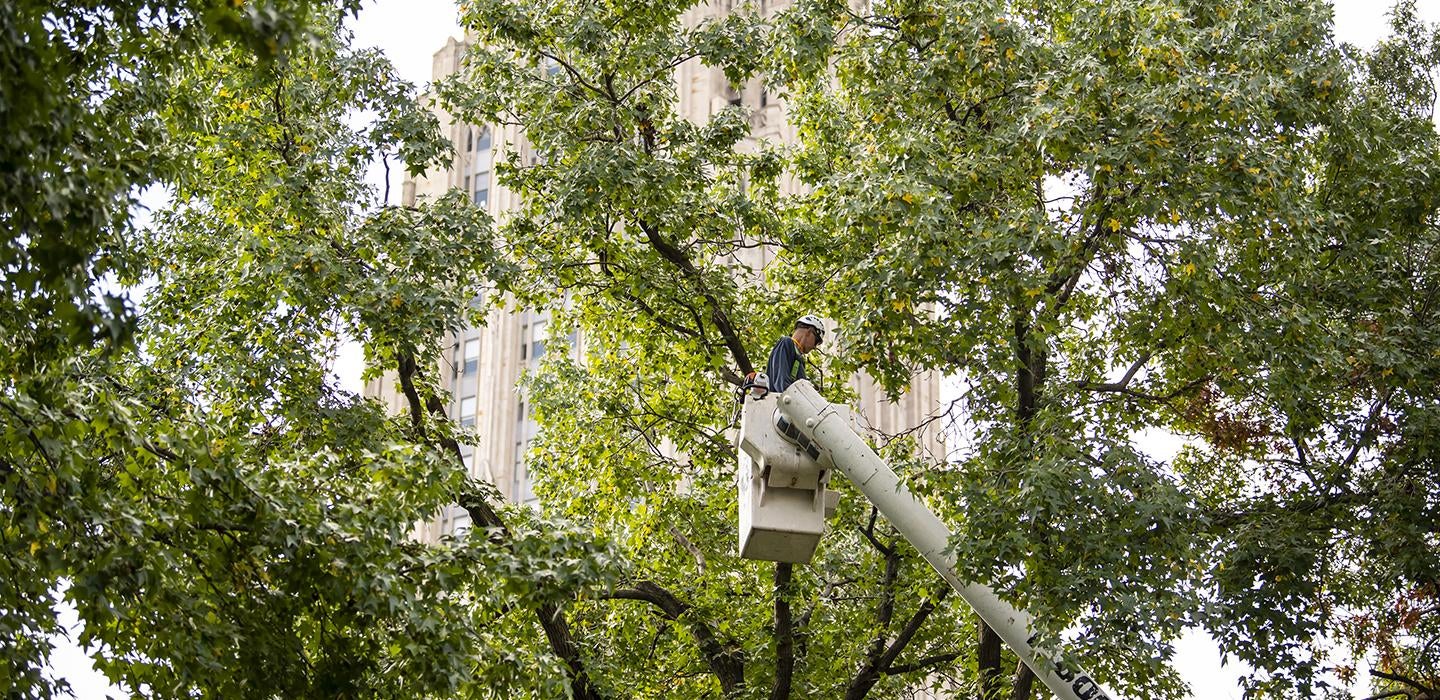
Subscribe to Pittwire Today
Get the most interesting and important stories from the University of Pittsburgh.It can be unsettling to see someone sawing down a giant oak or trimming branches from your favorite scholar tree on the Cathedral of Learning lawn, but it’s important work in keeping trees and forests healthy.
Pitt grounds crews and professional arborists regularly inspect the trees on the Pittsburgh campus for health, safety and insects — and sometimes they’re forced to remove limbs or take trees down as part of regular landscaping care. Unfortunately, a number of mature trees on the Cathedral of Learning lawn have succumbed to insects, disease or fungus and are scheduled to be removed this fall.
"If trees are insect-ridden, diseased, damaged due to extreme weather events or any combination of those things, sometimes you have to remove the threat to save the others," said Aurora Sharrard, Pitt’s director of sustainability.
Over the next year, dozens of new native trees will be planted throughout the Cathedral of Learning lawn to help replace those removed and to also increase the campus tree canopy.
"We have over 4,000 trees on campus, and we treasure our trees and open space," she said. "We are actively working to ensure we can responsibly steward our existing trees while making space and opportunity for future trees."
The Pitt Sustainability Plan, which outlines 60 goals in 15 impact areas, includes ecological and landscaping stewardship. If Pitt wants to meet its goal of increasing its tree canopy by 2030, Sharrard noted, pruning and planting are part of the process.
"We're losing trees in Pittsburgh at a faster rate than we'd like — and we're not planting them fast enough citywide," said Sharrard. "The goal at Pitt is to increase tree canopy by 2030 from our 2017 baseline while also replacing 15 percent of the lawn area with indigenous and native species by 2030."
Tracking the trees together
To track these tree-specific goals, develop a Campus Tree Care Plan and pursue a Tree Campus USA certification, the Campus Tree Advisory Committee was formed in 2019.
"The purpose of the committee is to support and help coordinate tree-centric activities and education across campus," said Sharrard. To ensure the inclusion of voices from across the Pitt community, members include students, faculty and staff.
And because Pitt's campus blends into business and city properties, the group collaborates with partners including Tree Pittsburgh and the Oakland Business Improvement District.
"It truly takes a village," said Sharrard. The Chancellor's Advisory Council on Sustainability and its Pollinator Habitat Advisory Committee have also contributed to the work.
"That's the best part of this job," Sharrard said. "We work on so many different topics and impacts across the University and in partnership with other organizations." She said she especially enjoys making the connection between what the committee does operationally with what Pitt does academically, helping "ensure that we balance equity, environment and economics, so everyone thrives."
The committee also includes Pitt faculty who are experts in ecology, landscapes and biology.
"We depend on expert input in this process and to support students who are interested in trees and in understanding their contributions to the larger ecosystem," said Sharrard.
Become a future tree tender
Beyond tree care and committees, Pitt Sustainability is working to get students, staff and faculty more involved in real-life stewardship projects. The first, Sharrard hopes, will launch in 2022.
"We're going to offer Pitt students and employees free training to become a true tree tender, which is a designation offered across Pennsylvania," she said. "The idea is to unite people who want to help Oakland and its trees thrive."
Because Pitt’s own trees are cared for by the grounds department, tree tenders who complete their training will be asked to commit to assisting the Oakland Planning and Development Corporation in tending the neighborhood's street trees.
"As a university, we're an anchor for Oakland," said Sharrard, “and committed to being a valuable partner in sustainability and beyond.”
She also expressed the need for tree planting, care and maintenance in other Pittsburgh neighborhoods — particularly those with fewer trees.
"Nationally, when you move from predominantly white, wealthy neighborhoods to BIPOC neighborhoods with a history of underinvestment, trees start to dwindle in numbers and age," she said. She went on to list the consequences of fewer trees, including increased urban heat, increased particle pollution and higher stress in humans.
"We have those same challenges in Pittsburgh, meaning we've identified great opportunities. Trees have a cascade of benefits. They manage stormwater, provide shade, improve physical and mental health, and even improve test scores. There are all sorts of amazing things about trees. We not only need them, but we need more of them. Pittsburgh needs a lot more of trees."
— Kara Henderson


